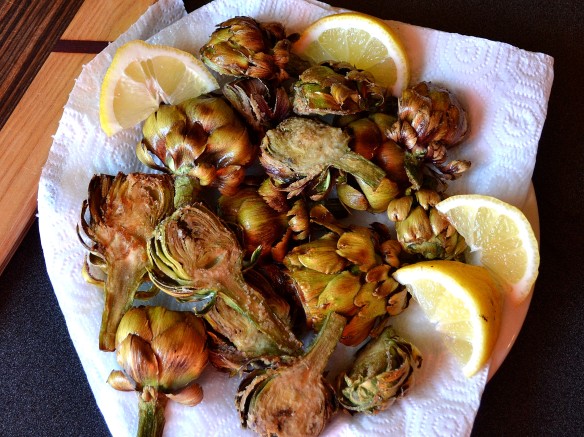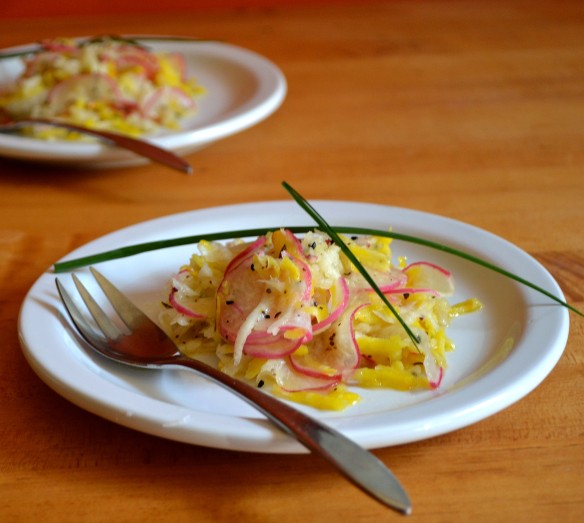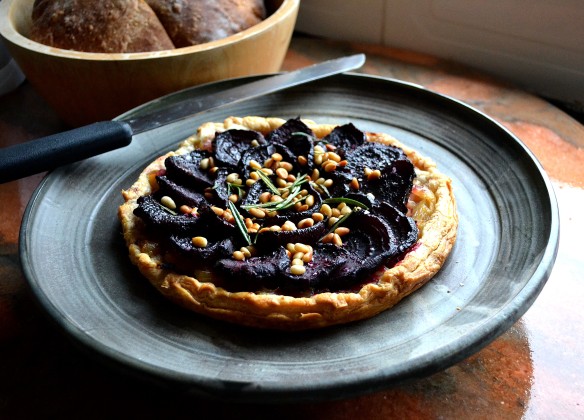 As luck would have it, the very first vegetarian main I trialed for Thanksgiving was such a winner that I did not need to attempt others. This aubergine and lentil pie hits all the right notes: it is hearty and savory without being heavy, and it’s a touch exotic yet wholesome enough to complement a traditional Thanksgiving dinner. It is also beautiful and can be cooked the day before you intend to serve it without losing any flavor or texture upon reheating. (I even thought the flavor improved after a day.) It is exactly what I was looking for – something special, festive, and autumnal for the vegetarians at the table. This pie is adapted from a recipe in Dan Lepard’s excellent home baking book, Short and Sweet. I have changed the spicing of the pie’s filling from Lepard’s original, but he deserves credit for the inspiration, the proportions, and the marvelous crust. Continue reading
As luck would have it, the very first vegetarian main I trialed for Thanksgiving was such a winner that I did not need to attempt others. This aubergine and lentil pie hits all the right notes: it is hearty and savory without being heavy, and it’s a touch exotic yet wholesome enough to complement a traditional Thanksgiving dinner. It is also beautiful and can be cooked the day before you intend to serve it without losing any flavor or texture upon reheating. (I even thought the flavor improved after a day.) It is exactly what I was looking for – something special, festive, and autumnal for the vegetarians at the table. This pie is adapted from a recipe in Dan Lepard’s excellent home baking book, Short and Sweet. I have changed the spicing of the pie’s filling from Lepard’s original, but he deserves credit for the inspiration, the proportions, and the marvelous crust. Continue reading
Category Archives: Vegetarian
Herbed Farro and Cauliflower
 Any holiday centered around preparing and consuming abundant amounts of food is right up my street. In the United States, this holiday is Thanksgiving, and in the UK it’s Christmas. I love to cook for my friends and loved ones, and I consider my job well done when, after the meal, the people I have fed flop and groan like sunning walruses. I have my tried and true methods (brined and convection-roasted turkey, always) and my favorite recipes (cornbread, apricot, and chestnut stuffing, and—I’m not ashamed to admit it—the Karo corn syrup pecan pie). Lately, however, my circle is expanding to include more non-meat eaters. Three years ago I was responsible for the vegan main at a Christmas dinner in London and this year, for the first time, more than half of our Thanksgiving table is vegetarian. I hate the thought of the vegetarian at a table of meat eaters feeling like an afterthought. The ‘you can eat the side dishes, that’s enough food, right?’ approach is both depressing and insulting. And mains intended to imitate the meat everyone else is eating (i.e., the dreaded Tofurky) are just plain depressing. So, over the next month (and especially over the next week), I hope to make and blog a number of tasty vegetarian dishes, hopefully to supply inspiration for your Thanksgiving (and Christmas) table. Continue reading
Any holiday centered around preparing and consuming abundant amounts of food is right up my street. In the United States, this holiday is Thanksgiving, and in the UK it’s Christmas. I love to cook for my friends and loved ones, and I consider my job well done when, after the meal, the people I have fed flop and groan like sunning walruses. I have my tried and true methods (brined and convection-roasted turkey, always) and my favorite recipes (cornbread, apricot, and chestnut stuffing, and—I’m not ashamed to admit it—the Karo corn syrup pecan pie). Lately, however, my circle is expanding to include more non-meat eaters. Three years ago I was responsible for the vegan main at a Christmas dinner in London and this year, for the first time, more than half of our Thanksgiving table is vegetarian. I hate the thought of the vegetarian at a table of meat eaters feeling like an afterthought. The ‘you can eat the side dishes, that’s enough food, right?’ approach is both depressing and insulting. And mains intended to imitate the meat everyone else is eating (i.e., the dreaded Tofurky) are just plain depressing. So, over the next month (and especially over the next week), I hope to make and blog a number of tasty vegetarian dishes, hopefully to supply inspiration for your Thanksgiving (and Christmas) table. Continue reading
Deep Fried Artichokes (Carciofi alla Giudia)
 Exactly four years ago, I drove down Route 1 in California from San Francisco to Los Angeles. Of course I vividly remember the spectacular coastline of Big Sur, I remember an elephant seal sanctuary near Hearst Castle (male elephant seals make a colossal racket when they’re fighting for territory), and I remember a creepy motel in Carmel. But, oddly, one of my clearest memories is the fried artichokes sold at farmstands along the roadside. Warm, salty, comfortingly greasy in a paper sack and undoubtedly bad for you, deep-fried artichokes will forever make me think of California.
Exactly four years ago, I drove down Route 1 in California from San Francisco to Los Angeles. Of course I vividly remember the spectacular coastline of Big Sur, I remember an elephant seal sanctuary near Hearst Castle (male elephant seals make a colossal racket when they’re fighting for territory), and I remember a creepy motel in Carmel. But, oddly, one of my clearest memories is the fried artichokes sold at farmstands along the roadside. Warm, salty, comfortingly greasy in a paper sack and undoubtedly bad for you, deep-fried artichokes will forever make me think of California.
My romance with fried artichokes began the first time I ate carciofi alla giudia (literally, artichokes in the Jewish style), which are fried artichokes sold in Kosher restaurants in the old Jewish quarter of Rome. Roman-style fried artichokes are made differently and more simply than the fried artichokes I ate in California. There is no batter. Purists won’t even flour their artichokes, although I do because I think it adds texture and helps bind the seasoning to the artichokes. Continue reading
Kohlrabi, Radish, and Golden Beet Slaw with Pickling Spices
 The second installment in the “how to use my CSA box vegetables” series is one of my favorite salads. I like to say that it’s a ‘cheat’: it’s a fresh vegetable slaw made with a tart dressing and pickling spices, and the result is that it tricks your brain (or at least my brain) into thinking “pickle.” It is crisp and light and bracingly flavorful. It’s a wonderful summer slaw, and a good alternative to traditional creamy cole slaws. Continue reading
The second installment in the “how to use my CSA box vegetables” series is one of my favorite salads. I like to say that it’s a ‘cheat’: it’s a fresh vegetable slaw made with a tart dressing and pickling spices, and the result is that it tricks your brain (or at least my brain) into thinking “pickle.” It is crisp and light and bracingly flavorful. It’s a wonderful summer slaw, and a good alternative to traditional creamy cole slaws. Continue reading
Swiss Chard Spanakopita
 It’s that time in late Spring when most well-intentioned locavores start to feel a little worn out. This condition, known to some as “CSA fatigue,” arises after about the fifth consecutive week that you’ve gone to the Farmers Market to find that each stall carries iterations of the same greens. Mustard greens, kale, more kale, chard, radishes. If you’re lucky, maybe the odd bunch of asparagus. You’ve eaten salads with every meal, it feels like. You’ve never been so ‘regular’ in your life. You’ve started to think longingly and guiltily about tomatoes – luscious, sweet tomatoes – no doubt flown in hundreds of miles and so verboten. In god’s name, how many different things can you do with Swiss chard? Continue reading
It’s that time in late Spring when most well-intentioned locavores start to feel a little worn out. This condition, known to some as “CSA fatigue,” arises after about the fifth consecutive week that you’ve gone to the Farmers Market to find that each stall carries iterations of the same greens. Mustard greens, kale, more kale, chard, radishes. If you’re lucky, maybe the odd bunch of asparagus. You’ve eaten salads with every meal, it feels like. You’ve never been so ‘regular’ in your life. You’ve started to think longingly and guiltily about tomatoes – luscious, sweet tomatoes – no doubt flown in hundreds of miles and so verboten. In god’s name, how many different things can you do with Swiss chard? Continue reading
Caramelized Onion, Apple, and Beetroot Tart
 I had never heard the term “the hungry months” until I came to London. Going to farmers markets in February and March, however, it takes on resonance. There are bins of tubers, alliums, parsnips, beets, last fall’s apples, and not much else. If you want to do truly locavore eating in the chilly North, these foods are your staple ingredients. But they are cheap! And, actually, wonderfully versatile. For example, the under-regarded onion is marvellously adaptable. Last week, I bought a lot of monstrous firm yellow onions thinking I’d use them for onion jam. From that initial premise sprang this tart, in which the onion jam is modified into a gently sweet onion and apple compote, topped with beetroots that have first been slow roasted, and served on crispy puff pastry with pinenuts and rosemary. The end result doesn’t taste like winter food at all; it tastes sunny and Mediterranean, like something you’d enjoy on a terrace with a glass of crisp white wine. Continue reading
I had never heard the term “the hungry months” until I came to London. Going to farmers markets in February and March, however, it takes on resonance. There are bins of tubers, alliums, parsnips, beets, last fall’s apples, and not much else. If you want to do truly locavore eating in the chilly North, these foods are your staple ingredients. But they are cheap! And, actually, wonderfully versatile. For example, the under-regarded onion is marvellously adaptable. Last week, I bought a lot of monstrous firm yellow onions thinking I’d use them for onion jam. From that initial premise sprang this tart, in which the onion jam is modified into a gently sweet onion and apple compote, topped with beetroots that have first been slow roasted, and served on crispy puff pastry with pinenuts and rosemary. The end result doesn’t taste like winter food at all; it tastes sunny and Mediterranean, like something you’d enjoy on a terrace with a glass of crisp white wine. Continue reading
Awadh-Style Curried Asian Eggplant
 The versatile aubergine is so gloriously exotic that it should occupy some mystical plateau, like chocolate. The Mayans weren’t mixing eggplants into their sacred ceremonial brews, but they should have been. The idea is not so farfetched, either – the eggplant apparently contains more nicotine than any other plant except tobacco (although you would have to consume 20 pounds of eggplant to ingest the same amount of nicotine in a cigarette). And of course the eggplant is a member of the nightshade family (along with potatoes, tomatoes, and capsicums). For this Awadh curry I used Asian eggplants, which have thinner skin and more delicate flesh than Italian eggplants. Unlike Italian eggplants, Asian eggplants do not have to be peeled: the skin is tender and not bitter. Fully cooked, Asian eggplants have a consistency like hot custard. Hot, savory, delicious umami custard. Continue reading
The versatile aubergine is so gloriously exotic that it should occupy some mystical plateau, like chocolate. The Mayans weren’t mixing eggplants into their sacred ceremonial brews, but they should have been. The idea is not so farfetched, either – the eggplant apparently contains more nicotine than any other plant except tobacco (although you would have to consume 20 pounds of eggplant to ingest the same amount of nicotine in a cigarette). And of course the eggplant is a member of the nightshade family (along with potatoes, tomatoes, and capsicums). For this Awadh curry I used Asian eggplants, which have thinner skin and more delicate flesh than Italian eggplants. Unlike Italian eggplants, Asian eggplants do not have to be peeled: the skin is tender and not bitter. Fully cooked, Asian eggplants have a consistency like hot custard. Hot, savory, delicious umami custard. Continue reading
Cheddar, Cider, and Leek Soup
 Why is it that when it’s cold and icky outside, hot food tastes so much better in liquid form? When I say it’s “soup weather’, what I really want is to be enveloped in soup. I want a soup hug. I told my father on a particularly gray and unpleasant day last week that I was making a cheddar, cider, and leek soup. He said it sounded “disgusting.” My father is wrong. This soup is GREAT – it’s like a lazy afternoon in a warm pub when it’s chilly outside, in a bowl, for lunch. Continue reading
Why is it that when it’s cold and icky outside, hot food tastes so much better in liquid form? When I say it’s “soup weather’, what I really want is to be enveloped in soup. I want a soup hug. I told my father on a particularly gray and unpleasant day last week that I was making a cheddar, cider, and leek soup. He said it sounded “disgusting.” My father is wrong. This soup is GREAT – it’s like a lazy afternoon in a warm pub when it’s chilly outside, in a bowl, for lunch. Continue reading
Garlic and Puy Lentil Soup with Smoked Paprika and Spicy Greens
 There are few flavour combinations that I like so well as garlic and paprika. Married to one another, garlic and paprika have a greater-than-the-sum-of-their-parts appeal, a briny, lingering, and distinctive aroma and flavour that work equally well with seafood and meat, with pulses and with vegetables. I am, of course, immensely fond of Spanish food, which some might say has its foundations in this happy union. Paprika, or pimentón, supposedly was brought to Spain from the Americas by Christopher Columbus, and it has become such an integral part of Spanish food that in Spain, paprika is rigorously regulated for quality, with denominations of origin, like wine and olive oil. When cooking with paprika, invest in high-quality Spanish paprika (it makes such a difference), and keep both sweet and smoked in your cupboard – you’ll use both. Continue reading
There are few flavour combinations that I like so well as garlic and paprika. Married to one another, garlic and paprika have a greater-than-the-sum-of-their-parts appeal, a briny, lingering, and distinctive aroma and flavour that work equally well with seafood and meat, with pulses and with vegetables. I am, of course, immensely fond of Spanish food, which some might say has its foundations in this happy union. Paprika, or pimentón, supposedly was brought to Spain from the Americas by Christopher Columbus, and it has become such an integral part of Spanish food that in Spain, paprika is rigorously regulated for quality, with denominations of origin, like wine and olive oil. When cooking with paprika, invest in high-quality Spanish paprika (it makes such a difference), and keep both sweet and smoked in your cupboard – you’ll use both. Continue reading
Chłodnik (Chilled Polish Beet Soup)
 Apparently the propitiation of the sun gods has worked: London has finally gotten a real hit of summer this week, and what a glorious week it’s been. People here are giddy; delirious even. Bathed in lambent sunlight, the narrow passageways and brick soften. The city at once feels broader and more open, and more risqué. London’s decided to show some milky-white leg. My flat has windows that face east and west. In the winter, when the sun sets at four o’clock, these windows are a lifesaver. These past few days, however, the afternoon sun has baked my front room to a sub-tropical heat. Working at home, I douse my top in water (a trick I learned from a friend who had family in Death Valley) and type until the water evaporates.
Apparently the propitiation of the sun gods has worked: London has finally gotten a real hit of summer this week, and what a glorious week it’s been. People here are giddy; delirious even. Bathed in lambent sunlight, the narrow passageways and brick soften. The city at once feels broader and more open, and more risqué. London’s decided to show some milky-white leg. My flat has windows that face east and west. In the winter, when the sun sets at four o’clock, these windows are a lifesaver. These past few days, however, the afternoon sun has baked my front room to a sub-tropical heat. Working at home, I douse my top in water (a trick I learned from a friend who had family in Death Valley) and type until the water evaporates.
When I lived in Seattle, during the hot summers (they can and do get hot) I’d make a soup that I knew of only as my mother’s cold summer beet soup. I’d make it by the pitcher, pour it into glasses, and drink it. When the pitcher was empty, I’d make another batch. Soon friends in the know would drop by for some in the afternoons. Vividly pink-magenta, this soup is delightfully sweet-tangy and refreshing; it gives gazpacho a run for its money. I only learned its Polish name when I decided to make it for this blog. Continue reading
